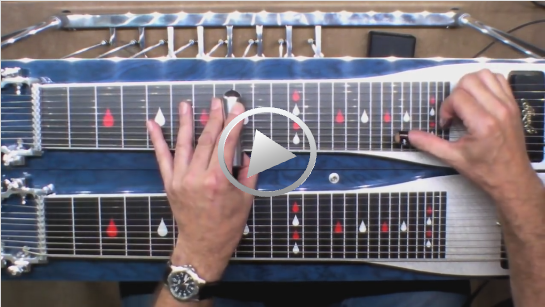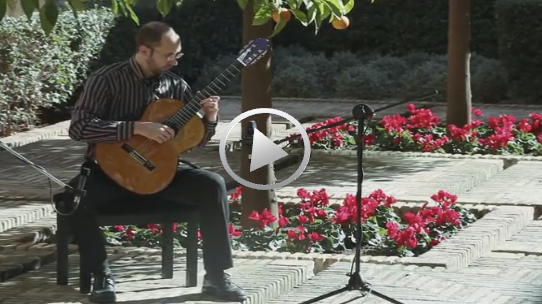巴洛克吉他 演奏 Canarios (卡那里欧斯舞曲)
The rhythm of the drums seckill Brainwashing
巴洛克吉他 – 创新和革命的产物
Radical Innovations, Social Revolution and the Baroque Guitar
作者 Craig H. Russell
翻译 韩洪涛
一、巴洛克吉他的定弦
巴洛克吉他同它的年轻的同胞- 六弦“古典吉他”大不相同。巴洛克吉他的琴体要小得多,弦长短,琴体上下部分的弯曲度更为修长。与十九世纪由安东尼奥·托雷斯所开发的“扇形音梁”支撑结构不同,巴洛克吉他采用了在其音孔两侧一对简单的平行撑梁,从而产生一种更为清谈、内在的音响。巴洛克吉他完美地利用了低张力的羊肠弦使这个乐器发出一种晶莹剔透、闪亮悦耳的音色。在某些弦的调音配置中,低音弦很少或者根本没有,因此其水晶般的高音就越发突出。同鲁特琴一样,巴洛克吉他的琴弦直接从琴桥上的孔中穿过与旋钮连接。这与现代吉他完全不同,现代吉他的琴弦从琴桥上的小孔穿过后,便立即越过一个由象牙或塑料做成的被称为“琴马”的东西。尽管从外观上看微不足道,但现代吉他的这一小小的添加便使其在音量上得以巨增。其原因在于,当某根弦被弹拨时,其振动便通过琴马有效地传递至面板。但巴洛克吉他琴弦的能量并没有直接激发面板的振动,而是被琴桥吸收了。
视频:巴洛克吉他演奏的《卡纳里奥斯》
古典吉他音域可以跨几个八度,六根(单)弦可以一直从低音扩展至高音音符;与之相比,巴洛克的音域就有限了,它并非是六弦,而采用的是五道(courses)复弦(每一组有可能是单弦,或者是一对相邻很近的套弦)。第一道通常是一根单弦,定音为e1(由于这根弦具有清晰的歌唱性,人们又称其为“高音歌者”),其它四道皆为两两一组的复弦道,共8根弦。从表面上看,所有的巴洛克吉他的标准定弦和现代吉他的前五根弦相似,及依次e1,b,g,d,a下行。巴洛克吉他的定音将现代吉他的定音从高到底进行了依次进行了复制(增加相同音的一根弦,见例10.2 a)。另一方面,巴洛克吉他还有可以体现更加明亮音质的其它定弦方式。比如,一种颇为流行的调弦方式将低音弦全都舍弃,而全部采用高音弦。这种定弦方式由第一道开始,前三弦由高到低为e1,b,g (弦现代吉他一样),但第四、第五道时突然向上跳跃至高音d1和a – 这样第三道的g音便成为这个乐器上最低的一组弦(见例10.2b)。一些吉他家将这种定弦方式称为“重入式”定弦,因为高音一开始逐步下行,但随之又“重新进入”乐器的调音。另外一种调弦方式是在第四道和第五道弦中,将一组的两个音分成高低八度音,这样这两组弦既有高音弦,也有低音弦。这样,在第四道中,d1就和d音形成一组,而第五道便是两个相差八度的A音了。接下来的一种定弦发的最低音便落在了第四道的低音d上(见例10.2d)。最后,有不少的器乐家还采用另外一种定弦法:将第三道弦组分成两个相差八度的音,这样最高的便是这道的g1了(见例10.2e)。
现代吉他和巴洛克吉他这些明显的区别并不只是学术猎奇上的不同,他们体现了不同艺术感知的核心区别。古典吉他在复调音乐和对位线条的互相交织的表现上非常完美。巴洛克吉他适合于表现主调音乐,而且是个理想的和弦弹奏乐器。古典吉他的大部分作品是独奏表演目的,更加适合于个人演奏而非合奏。巴洛克吉他在这方面正好相反,它的优势是更适合于合奏的表演。巴洛克吉他和古典吉他的音质截然不同:古典吉他气势雄伟、声音洪亮;巴洛克吉他含蓄内敛、清雅精致。
Baroque Guitar – the product of innovation and Revolution
Radical Innovations, Social Revolution and the Baroque Guitar
Author Craig H. Russell
Translation Han Hongtao
A baroque guitar tuning
Baroque guitar is quite different from its young sibling – the six string “classical guitar”. Baroque guitar body is much smaller, string length, the body of the upper and lower parts of the curvature is more slender. And in nineteenth Century by Antonio Torres developed the “fan sound beam supporting structure is different, the Baroque guitar in the hole on both sides of a simple parallel support beam, resulting in a more talk, inner sound. The Baroque guitar makes perfect use of low tension gut strings make this instrument emits a crystal clear, sparkling sweet tone. In some string tuning configurations, the bass strings are few or no, so their crystal treble becomes more prominent. Like the lute, Baroque guitar strings from the bridge directly through the hole in the connected with the knob. This is completely different from the modern guitar, modern guitar strings from the holes on the bridge after crossing, immediately across a made of ivory or plastic called “bridge”. Despite its slight appearance, the small addition of the modern guitar has greatly increased its volume. The reason is that when a string is plucked, the vibration is effectively transferred to the panel via the bridge. But the Baroque guitar string vibration energy is not directly stimulate the panel, but absorbed by the bridge.
Video: Baroque guitar “Khanna Rios”
The classical guitar range can span several eight degrees, six (single) has been extended to the string from the bass treble notes; in contrast, the Baroque range is limited, it is not the six string, and is used in five (courses) complex strings (each group may be Danxian, or a the adjacent closed strings). The first is usually a single string, tuning for E1 (because the string has clear singing, it is also known as the “Treble singers”), the other four are 221 groups of double strings, 8 strings. On the surface, the five strings are all standard Baroque guitar and modern guitar is similar, and in turn E1, B, G, D, a downlink. Baroque guitar accordatura modern guitar sound from high in the end were sequentially reproduced (add a string of the same sound, see example 10.2 a). On the other hand, there are other Baroque guitar can reflect more bright tone. For example, a popular way of tuning the bass string all give up, and all the treble strings. This tuning way starting from the first, before the Sanxian from high to low as E1, B, G (Modern guitar string like, fourth, fifth) but when suddenly jumping up to the high D1 and a – third g sound has become the instrument on a string with the lowest (see 10.2b). Some guitarists will this way are called “reentrant tuning, because a” Treble gradually down, but then “re entering the” musical instrument tuning. Another way is in tuning fourth and fifth chords, the two tone of a group is divided into high and low eight degrees of sound, so the two sets of strings both treble strings, with bass string. So, in fourth, D1 and Dyin formed a group, and the fifth is the difference between the two eight degree A sound. The next one has the lowest falls on the fourth bass D (see 10.2d). Finally, there are a lot of music also used another tuning method: third chords group into two different eight degree sound, this is the highest G1 (see 10.2e).
The obvious difference between Modern Guitar and Baroque guitar is not just the difference of academic novelty, they embody the core difference of different artistic perception. The classical guitar is perfect in the interweaving of Polyphony and counterpoint. Baroque guitar is suitable for the performance of melody, and is an ideal chord playing instrument. Most of the classical guitar works are solo performance purposes, which are more suitable for solo performance rather than ensemble. Baroque guitar is the opposite of this, and it has the advantage of being more suited to ensemble performance. Baroque guitar and classical guitar sound quality is different: classical guitar grand, loud sound; Baroque guitar implicit, elegant and delicate
视频来源网络 !如有侵权 ,请联系删除 论点和本频道无关
Video source network! If there is infringement, please
contact delete.
未经允许不得转载:環球樂器博览网 » 节奏秒杀 鼓点洗脑 巴洛克吉他 不同寻常
 環球樂器博览网
環球樂器博览网




评论前必须登录!
登陆 注册